Mere months have passed since the PS5’s hotly anticipated launch, and already there’s a class-action lawsuit brewing over joystick drift on Sony’s high-tech DualSense controllers. Who could have seen this coming? Well, as it turns out, everyone. Everyone should have seen this coming. Because for all its exciting new tech, the DualSense uses off-the-shelf joystick hardware with a long history of predictable, preventable issues. And now we’ve investigated those issues in excruciating detail.
Like the PlayStation 5 itself, the DualSense controller feels like a device brought back from the near-future. It has new adaptive triggers and advanced haptic feedback. Deeper inside, however, are joystick modules that could have been held over from when Seinfeld was on the air. In some ways they’re actually less sophisticated than certain joystick technology available in the late 1990s.
Sony isn’t the only company to use off-the-shelf joystick modules, but, like Microsoft, they’ve made it difficult to repair this consumable component. Joysticks have a known life expectancy—it’s listed right in a product sheet from the manufacturer. It’s predictable they would fail, which makes you wonder if it’s a willful cost-saving calculation on the console makers’ part to not offer more reliable, or replaceable, sticks.
Let’s head inside a DualSense controller to see what is failing, and how.
The potentiometer problem
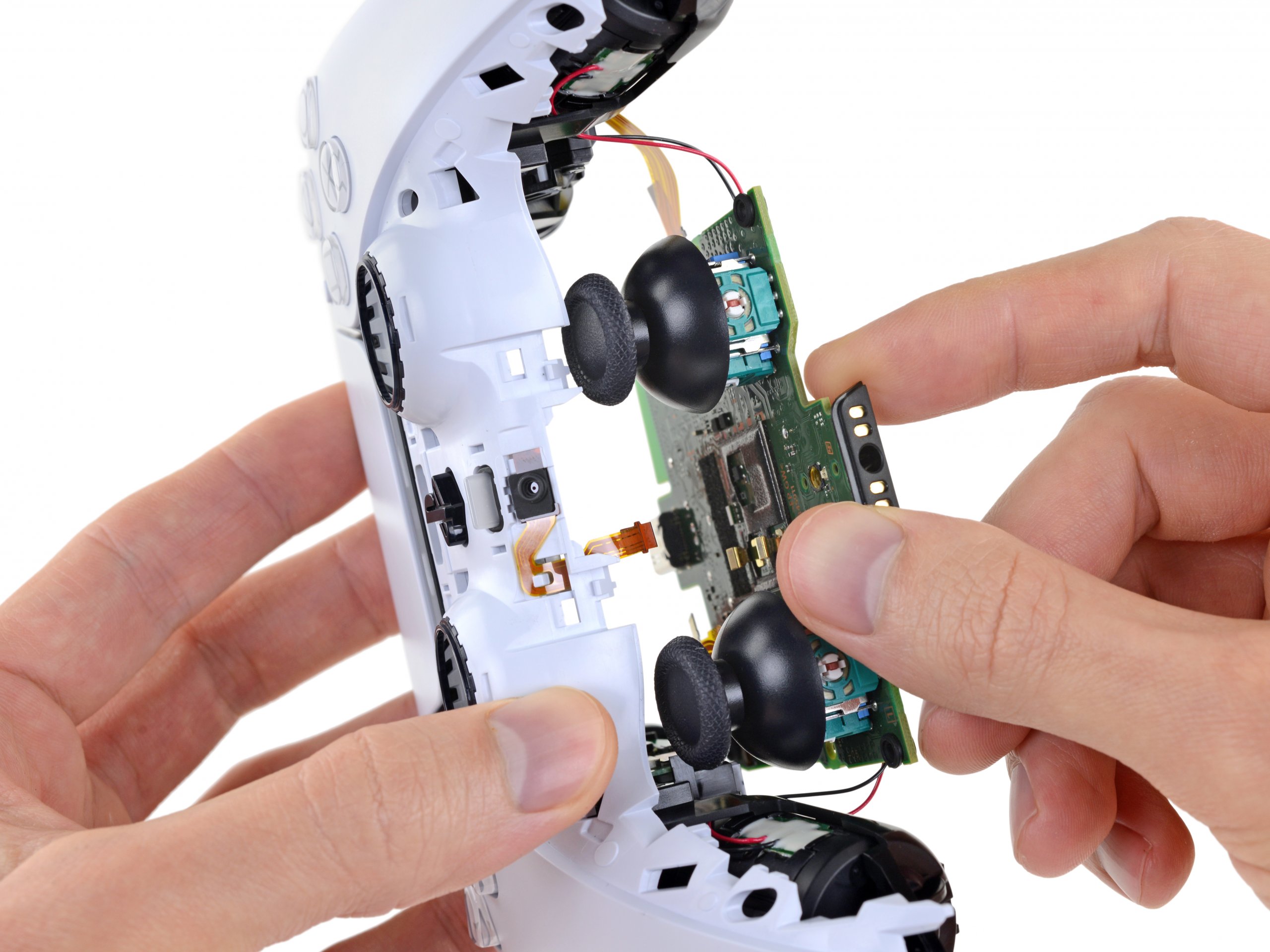
We gave a detailed blow-by-blow of the controller disassembly in our PS5 teardown, so here we’ll zoom right in on the joysticks. Unlike the buttons and analog directional pad, the DualSense thumbsticks sit directly atop the main controller board.
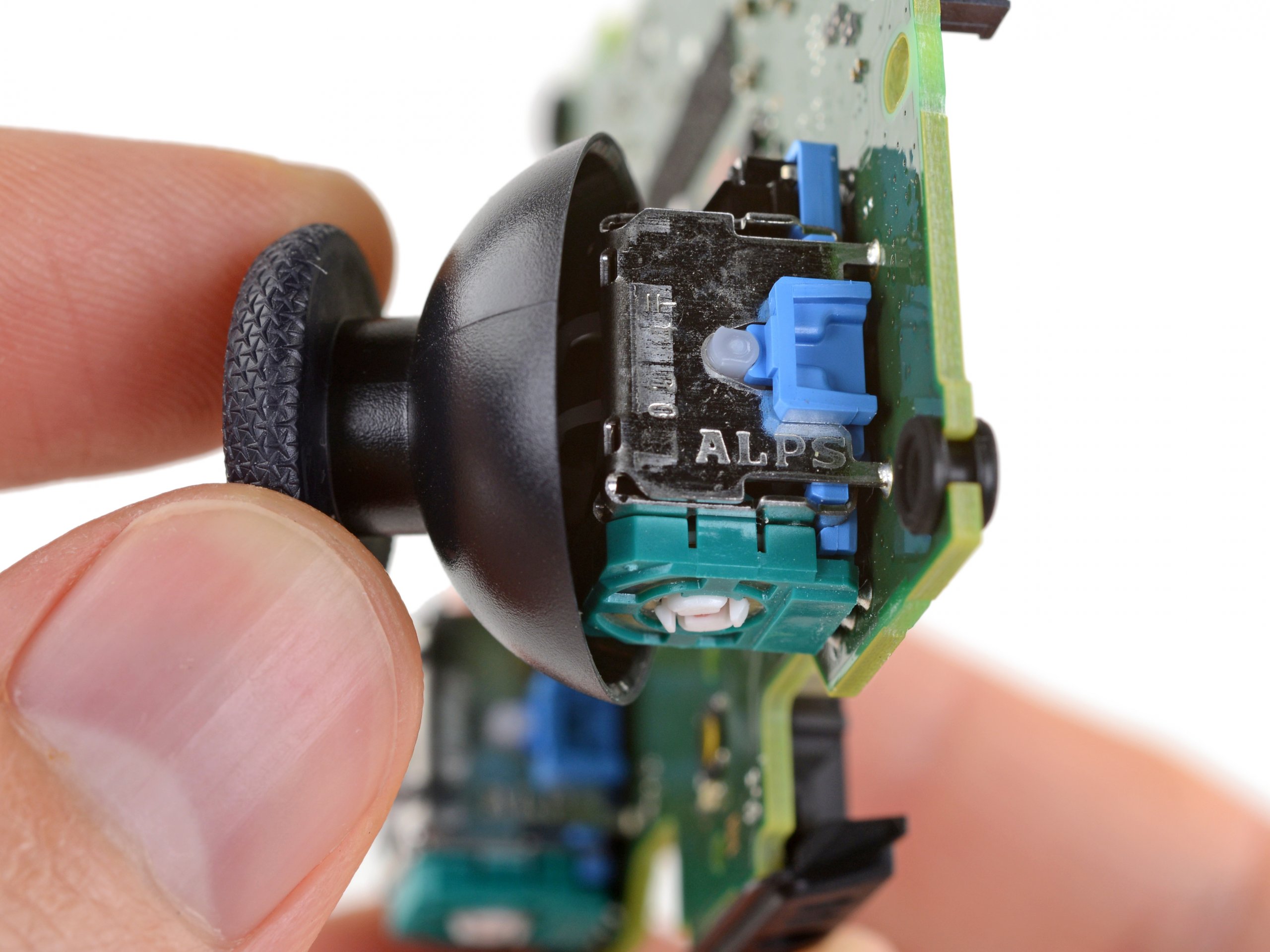
The joystick modules themselves are manufactured by Alps—a name familiar to anyone who has fallen down a deep keyboard hole, or struggled with a trackpad driver. The Japanese company (formerly Alps Electric, now Alps Alpine) specializes in input and sensing devices.
Tempting as it may be to blame Alps for the PS5’s drifting issues, they probably aren’t the villain of this story—because, brand name notwithstanding, this joystick module looks extremely familiar. You may already recognize it from the prior-gen PlayStation’s controller, the DualShock 4. Or from the Xbox One controllers. Maybe the Nintendo Switch Pro controller. Or, somewhat confusingly, the $180 Xbox One Elite controller. Underneath that plastic cap, the dirty secret is that they all use the same joystick hardware.
Getting a closer look requires a significant amount of effort. Both joystick modules are soldered to the controller board, with 16 solder joints apiece—including two wires to remove, for the haptic motors on each side.
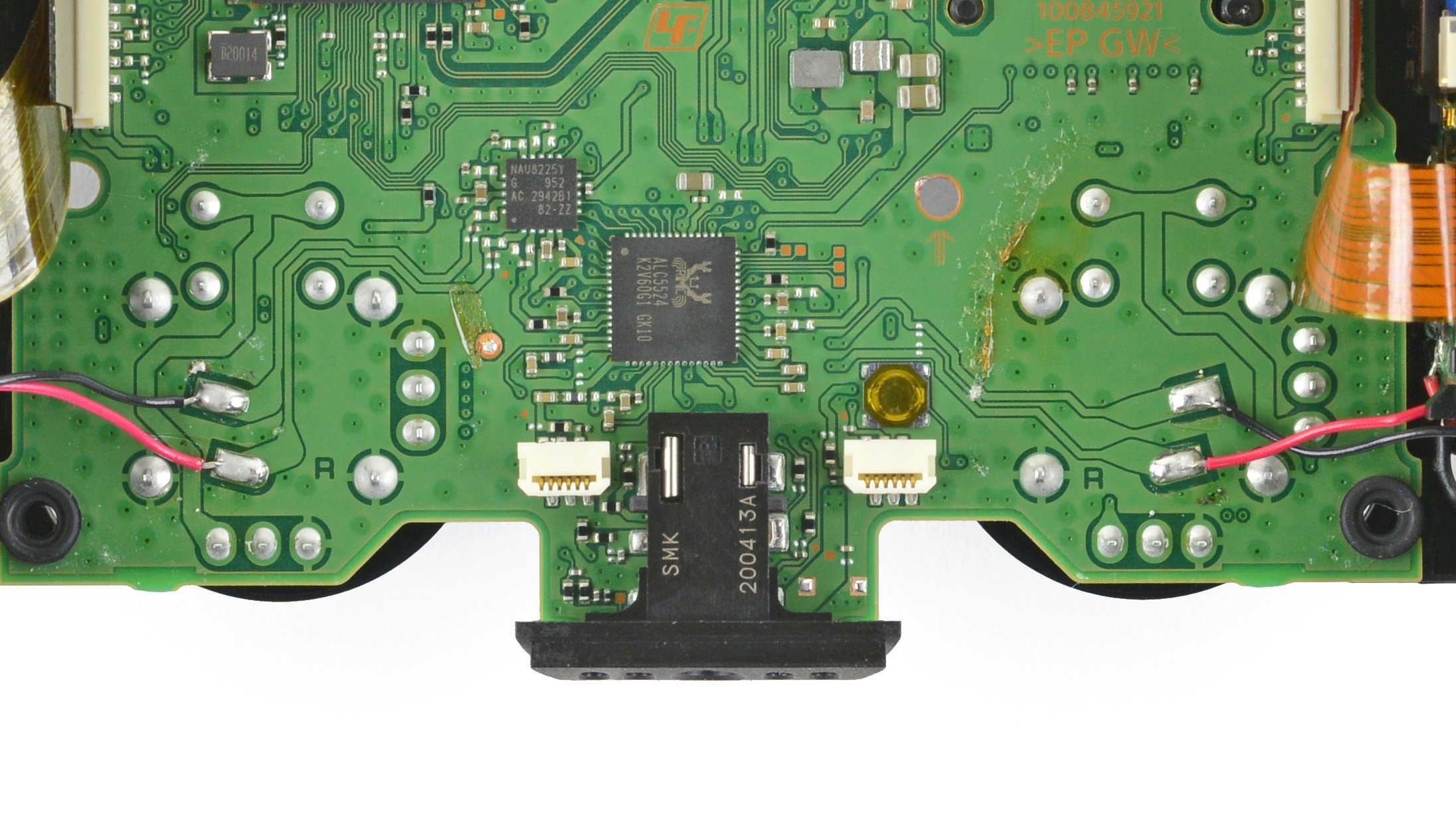
You’re not getting these joysticks out without soldering gear: at minimum an iron, flux, a desoldering braid and/or solder sucker, and patience. Or you could cover up all the other components with high-temperature tape, heat up a whole pot of solder, and dip it in for the win. We went a more traditional route, blasting it with hot air until the solder gave way.
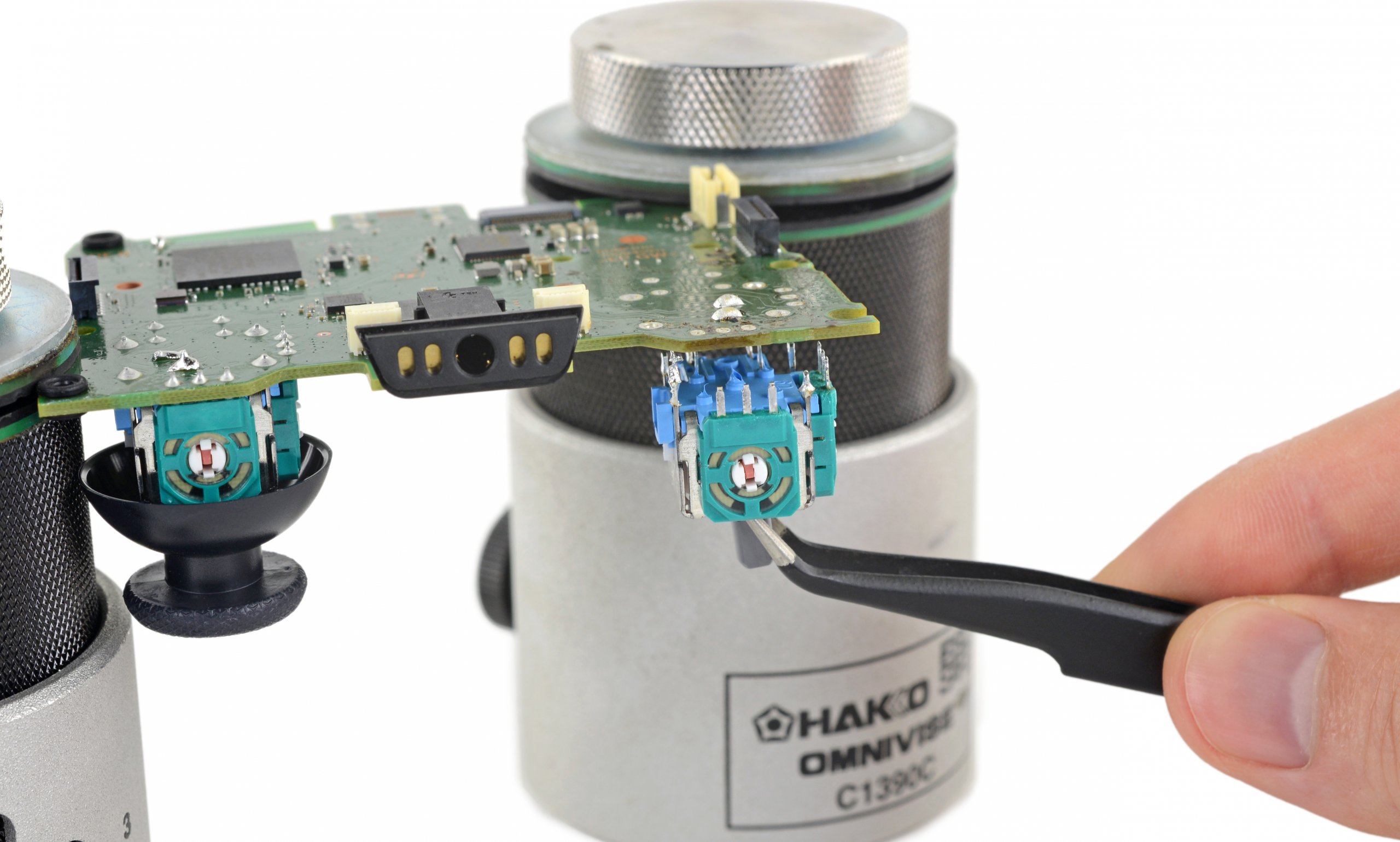
With the entire joystick module removed, we can pry it apart and survey what’s inside.
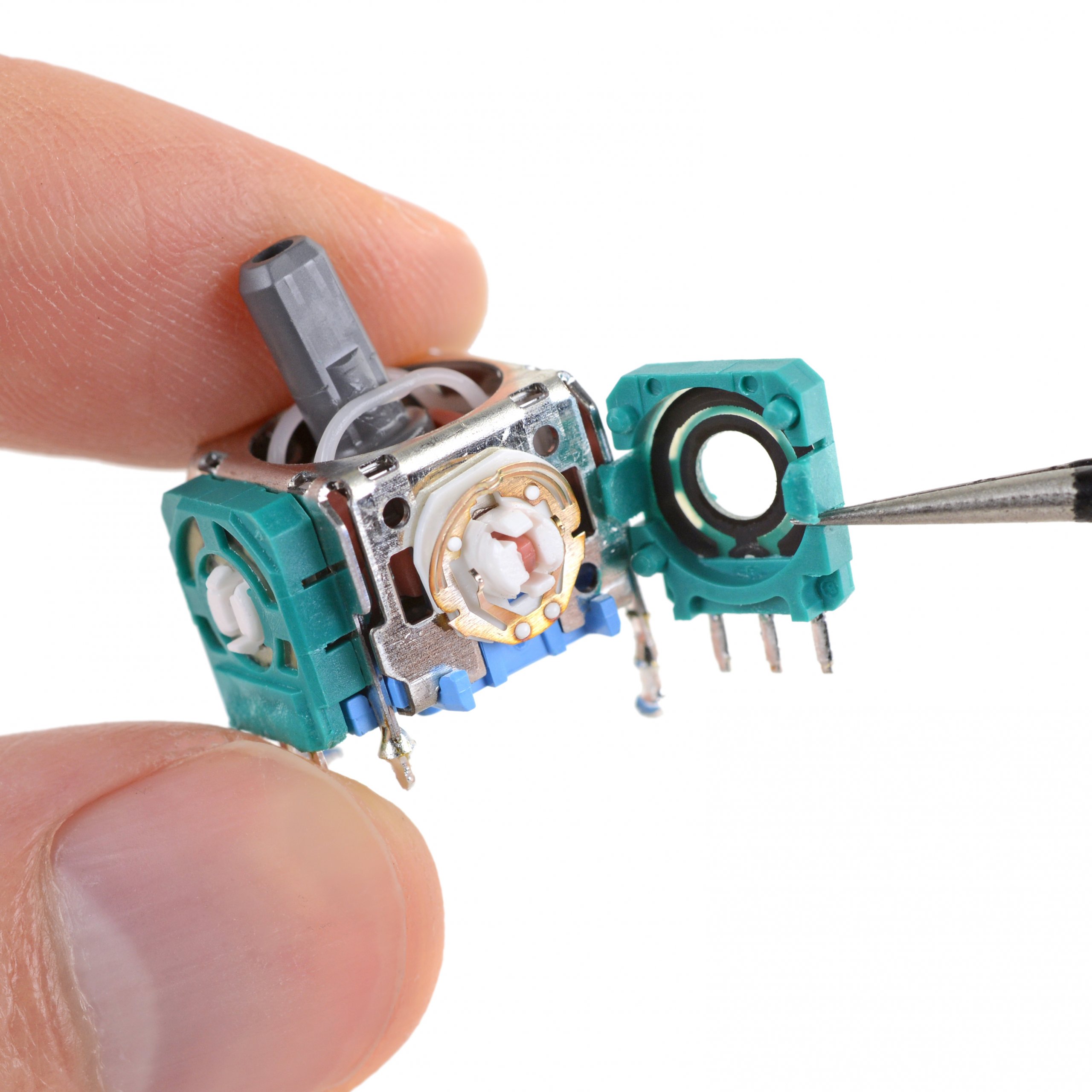
Each of these seafoam covers houses a potentiometer—that’s two per joystick, set perpendicular to each other. One potentiometer senses up/down movement, and the other left/right.
To understand the part they play, it’s helpful to know how a potentiometer goes about the business of measuring position. You start with a strip of material with a known, uniform resistance value—that is, how hard it tries to stop an electric current running through it. Put one terminal at each end, so you can apply a known voltage across the entire strip. Now add a third terminal, called a wiper, that slides back and forth along the strip. The voltage reading at the wiper changes predictably based on the wiper’s location—closer to one terminal or the other, or right in between.

The potentiometers in the DualSense joysticks work like that, except instead of moving back and forth in a straight line, the wiper races around a semicircular track made of printed carbon film. When you move the joystick with your thumb, it rotates two little shafts, one connected to each wiper. The wipers translate their positions into voltage values, which the controller reads to determine the joystick’s position and movement.
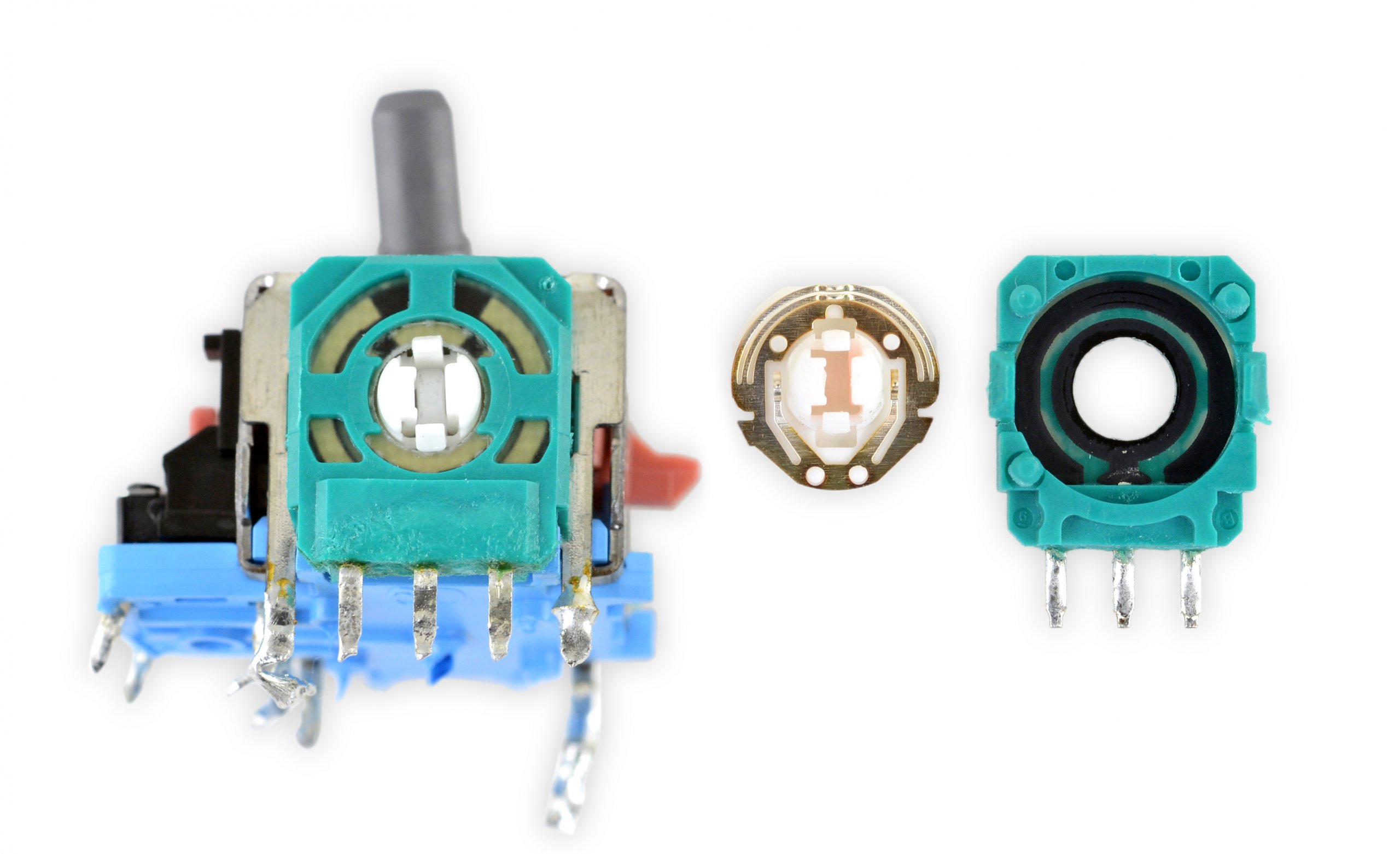
There are two other noteworthy components in the modern joystick. One is a spring that returns your joystick to a centered, neutral position when you let go. The other is the push-in button action that many controllers offer on their thumbsticks.
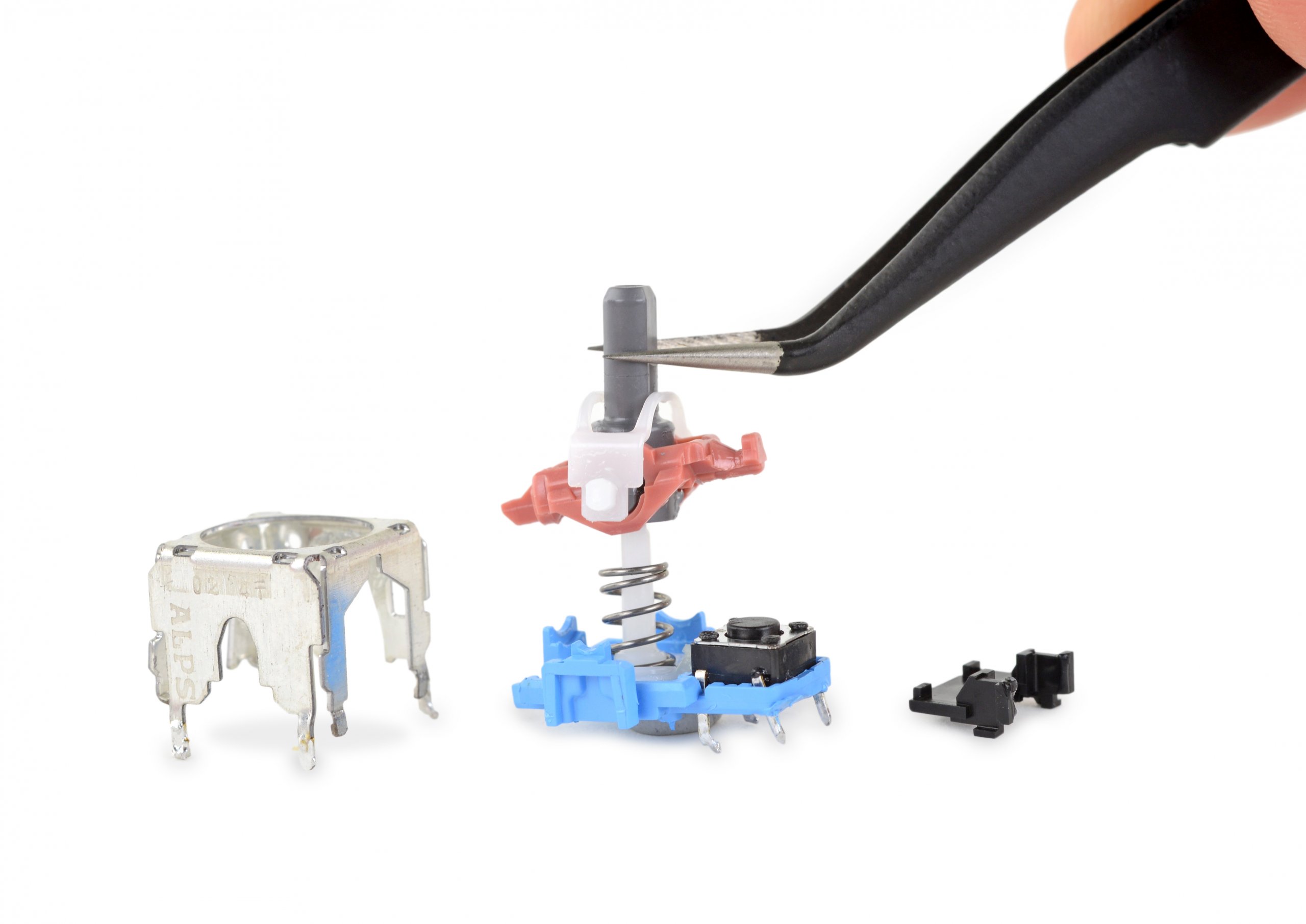
Knowing what we know about who made this thing and how it works, let’s move onto where it doesn’t work.
Why Drift Happens
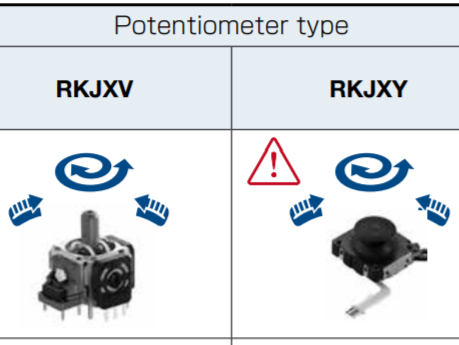
Who knows the particulars of the PS5 joysticks better than the company that makes them? Let’s take a look at Alps’ spec sheet for the RKJXV series, a ThumbPointer™ (Stick Controller) made for “Game” purposes. Search around eBay and other shopping sites, and you’ll see variants of this model number listed alongside many PlayStation, Xbox, and Switch Pro Controller joystick replacements. Right on page one of the product sheet is the operating life for the RKJXV’s potentiometers: 2,000,000 cycles.
One of our teardown engineers measured their own Call of Duty: Modern Warfare (2019) controller interactions for back-of-the-envelope joystick life math. Averaging ten different 30-second intervals, they made roughly 100 full potentiometer rotations per minute. If you play a less stick-intensive game than a first-person shooter, rotating 80 times per minute, you’ll hit 2,000,000 rotations in 25,000 minutes, or 417 hours—that’s just 209 days, playing 2 hours per day. At a more kinetic 120 rotations per minute, that’s 139 days at 2 hours per day. So Alps’ own rating for accurate joystick measurements is, in one gamer’s hypothetical experience, 4-7 months—and that’s with a very non-pandemic 2-hour cap on your game time.
That doesn’t necessarily mean your joystick will drift at that point—it could fail earlier, or keep working fine for much longer. But nothing lasts forever, and potentiometers are no exception. Here’s why.
1. Sensor wear
The first potential cause of drift is the hardest to avoid: wear to the potentiometers. Over time, the wiper scrubbing back and forth against the resistive pad creates imperfections, altering the voltage readings across the terminals—think of a skipping record or scratched CD. It’s worth noting that, while the Switch’s infamously drifty Joy-Con sticks look quite different internally, with wipers moving across flat pads instead of circular tracks, they can fail in exactly the same way: wear to the pads, resulting in incorrect readings.


2. Spring fatigue
Let’s not lay all the blame at the feet of these little resistors, though. In order to work, they have to measure joystick movements from a consistent, neutral starting point. As you move your joystick around, the spring-loaded self-centering mechanism can stretch slightly, creating a new “neutral” point. In this scenario, the potentiometers can still accurately read the relative position of the joystick, but that position is objectively incorrect.
3. Material stretching
That’s not to say that plastic stretching throughout the joystick isn’t a factor. You are, after all, constantly pushing joysticks against their limits, sometimes quite hard, whether drifting in Forza or stressfully racing the clock in Overcooked. We suspect this contributes more to a “looseness” in joystick pointing, rather than consistent slow-walking drift.
4. Grime, dust, moisture, and other gunk
Finally, there’s the boogeyman we’ve all been trying to ward off since the days of NES cartridges: contamination. For instance, the constant plastic-on-plastic grind of gaming creates plastic dust that can accumulate inside the joystick mechanism. Most modern controllers use self-lubricating plastics for smoother action. Self-lubricating ultimately means self-degrading; they work in part by sacrificing minute amounts of their own material.
We and others have had some success eliminating drift by cleaning out the potentiometer internals with compressed air, contact cleaner, and/or isopropyl alcohol. Often, though, without a full removal and reassembly, you’re just displacing dust, not removing it. It can wander back into your stick, while you continue generating more of it.
Then there’s contamination from the external world. Potentiometers are vulnerable to extreme temperatures, humidity, oxidation/corrosion, and yes, small particles. Your house is not a cleanroom.
Attempted fixes, including calibration, and why they only sometimes work
If you don’t want to solder, there are plenty of YouTube videos demonstrating purported drifty joystick fixes that don’t require heat—just a lot of patience, and sometimes fine motor skills. You could, for example, pry off the housings of the potentiometers and either clean or replace the rotating wiper. Or you might try carefully cleaning both the wiper and its graphite track. Some folks have tried physically twisting the potentiometer hardware ever so slightly in order to offset slightly incorrect position readings.
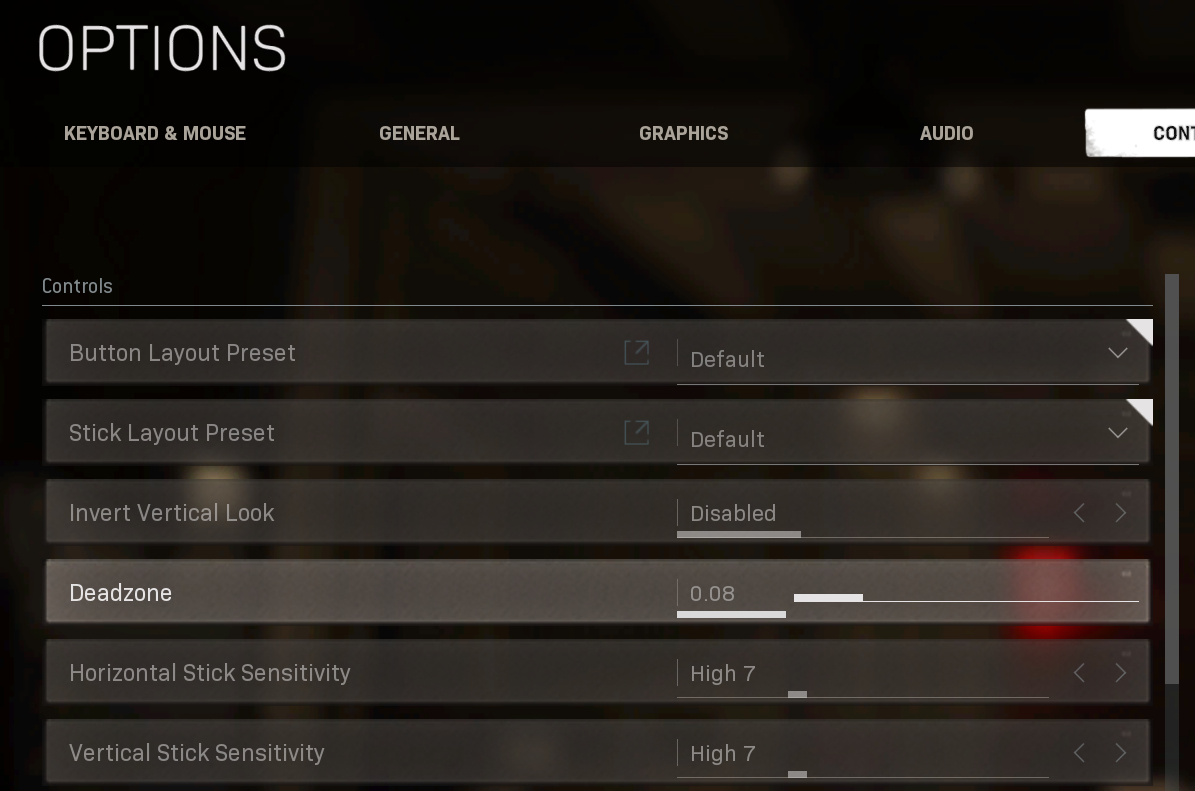
Some consoles, and even some games, offer joystick or dead zone calibration, which can help put a band-aid on many of these issues. But there are a few problems with software calibration:
- Calibration can help if you have a consistent, uni-directional issue with your joystick’s centering mechanism (return spring). It won’t fix general “looseness” or a worn-out spot on a potentiometer.
- The fix for some kinds of looseness is a “dead zone” calibration. This makes games ignore minor movements of the stick. But if the problem worsens, you have to expand the dead zone to compensate, making finer joystick control impossible.
- Contamination is, as you might expect, not something that software can work around.
Then there’s the class of fixes that do require soldering, and even here the situation scarcely improves. Brand-new joysticks right from the factory are known for having a lot of variance in the resistance values in their individual potentiometers, which requires… you guessed it, software calibration at the factory. That calibration profile is stored on the controller board, not in the joystick itself. Without the factory calibration tool, brand-new replacement joysticks can—ahem—drift. Undeterred by this, heroic fixers have devised one tedious workaround after another. Suffice to say, these things could be a lot easier to fix.
The real fix is better choices by console makers
If you’re experiencing drift on your controller, you have three real options: Fix it (either yourself or through an experienced tech), send the controller back to the manufacturer and wait for a fix (if it’s warrantied/covered), or buy a new one. It’s bizarre to us that the console makers, who spend countless thousands of hours obsessing over their controller designs, don’t just concede that joysticks are consumable parts, and design them as such to be more easily replaced.
No device, rated for 2,000,000 cycles, especially a vessel of frustration or obsession, can maintain perfect performance forever. They should be designed with that reality in mind. Nintendo, for all its extended silence on Joy-Con drift failures, at least chose an easily replaceable joystick secured by Phillips screws and a flexible cable, not 16 solder joints. And even if a joystick needs the stability of solder beneath it, it’s possible to design a “breakout board,” such as we often see on phones and other portable devices. A smaller circuit board would hold the joystick and its necessary wires and chips, then connect to the main board with a detachable cable.
That’s just the obvious stuff. You could dream bigger and design pin sockets for the controller module, like the kind seen on the ErgoDox keyboard. Even better: a modular controller like the Astro, which doesn’t look much bulkier than other modern controllers, but features no-solder-needed swap-able parts. Just try and convince us that console companies couldn’t make a mint selling limited edition themed controller parts.
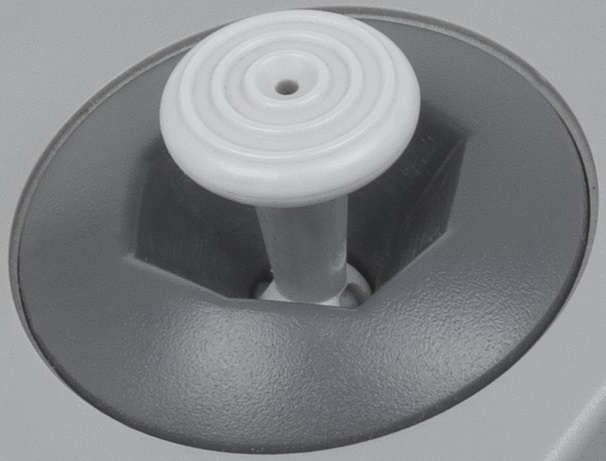
Evan-Amos, CC0 / Wikimedia Commons
Console makers could also choose more reliable joystick hardware in the first place. The Dreamcast, circa 1999, used Hall Effect sensors in its controllers. The magnets could wear out over a very long timeline, but magnets are also replaceable. Inside the N64’s center joystick were optical sensors that read input much like an older ball mouse. The joystick itself was susceptible to physical sag and leaning, but the sensors were likely still reading true.
In the end, then, the real culprits of drift are humans, and profits. These controllers are cheaper to produce up-front, but more expensive to fix when they fail. Perhaps gaming companies can’t reconcile the obvious truth that joysticks fail with the image of their technology as immaculate, bleeding-edge, a completely seamless entertainment experience. But we think most people would prefer to be a bit more realistic about something as unglamorous as a thumbstick. It beats mailing out a controller, or buying another $70 controller to replace an 88-cent part.
Note: We reached out to Alps Alpine, Sony, and Nintendo for comment on this post; we did not hear back before publishing.





31条评论
So is there a table where we can see which companies use ALPS?
Joshua M - 回复
As the article stated, ALPS's pots are not the issue. In fact outside of controllers they have reputation for being very well made and reliable. The issue is game console companies using potentiometers instead of hall effect or optical sensors ad/or customers not wanting to pay for inherently more expensive controllers with hall effect sensors.
Køøl Düderino -
“Note: We reached out to Alps Alpine, Sony, and Nintendo for comment on this post; we did not hear back before publishing.” You could also disclose that microsoft while using the exact same parts, actually funded this article
repairguy221 - 回复
Interesting! How do you know that?
Alan H -
Really need to drop the PS5 from the title of this article, whilst it is pertinent that DualSense's are being affected already, it’s clear that this is a universal problem and should be addressed as such rather than being misleading with your headline.
yenrug - 回复